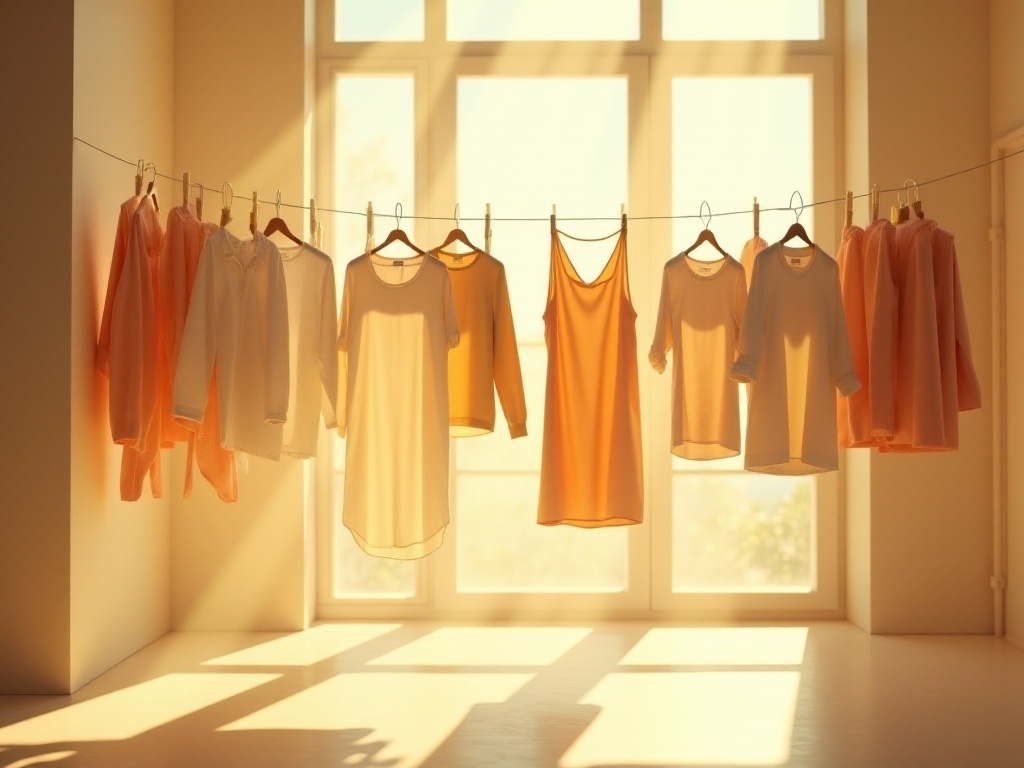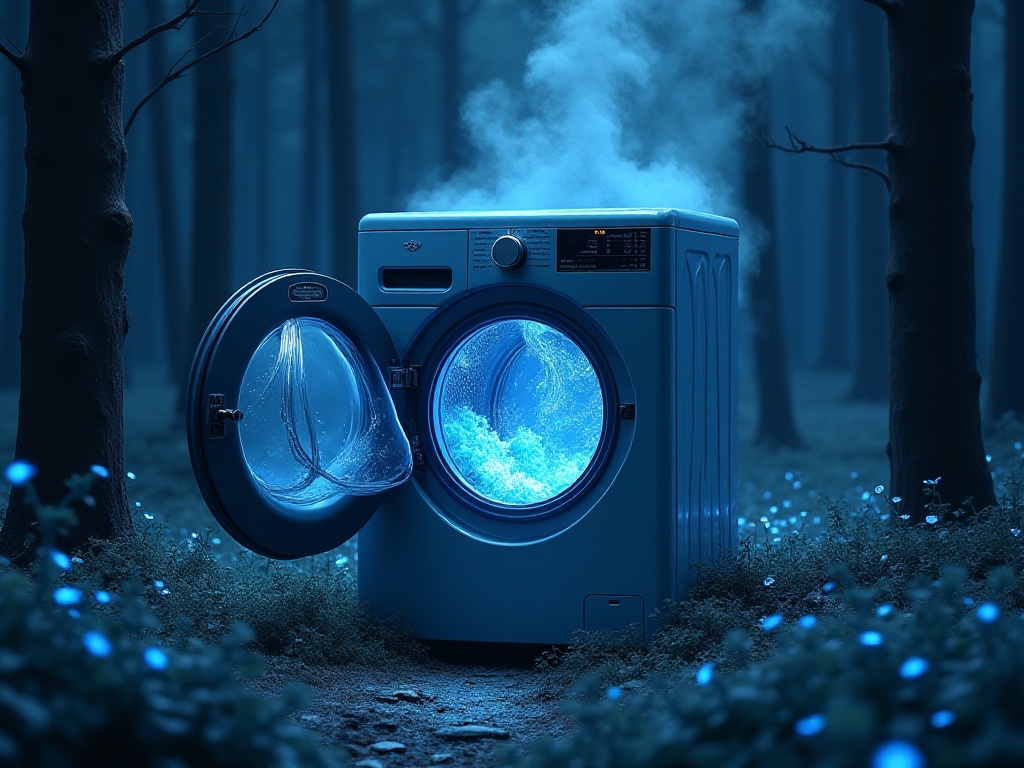Introduction
Do you find yourself worrying about washing and maintaining your clothes every time you open your closet? Should this piece be washed? What water temperature is suitable for that garment? As a 90s blogger passionate about life efficiency, I want to share with you the clothing care secrets I've gathered through countless trials and errors over the years. To be honest, when I first started living independently, I was a complete laundry novice, often ruining my clothes in the wash. After years of exploration and learning, I've finally found the clothing care method that works best for me, and I hope my experience can provide some inspiration for those facing similar challenges.
Less Washing is Better
Many people have a deep-rooted belief: any worn clothing must go in the laundry basket, whether it's dirty or not. Whenever I see my roommates doing this, I can't help but want to urge them to reconsider. Over-washing not only accelerates clothing wear, making your clothes thinner and looser with each wash, but more importantly, it causes enormous waste of resources.
According to statistics from authoritative environmental organizations, washing accounts for a staggering 75% of energy consumption throughout the entire lifecycle of a regular cotton T-shirt, from production to final disposal. This number is truly shocking. Think about it - if we could reduce unnecessary washing, we could not only make our clothes last longer but also save significant energy for the planet.
I've now developed a good habit: every time I take off clothes, I first do an "inspection." Specifically, I ask myself three questions: First, is this piece actually dirty? Are there any visible stains? Second, does it smell? Third, is this an undergarment? If the answer to all three questions is no, then the piece can be aired out and worn again.
Especially for non-body-contact outerwear like sweaters, suits, and jackets, they really don't need to go into the washing machine after each wear. I've specifically set up a dedicated clothes rack area on my balcony at home for airing out these types of clothes. Every night when I get home, I hang the day's outerwear there to catch some breeze and naturally air dry. By the next morning, these clothes are fresh again, no different from freshly washed ones.
Another tip is choosing suitable hangers. Regular wire hangers might leave unsightly bumps on clothing shoulders, so I always choose wooden hangers with gentle curves. Although they're more expensive, they maintain the clothes' shape well, definitely worth the investment.

The Art of Sorting
When it comes to laundry, the most common mistake is washing everything together without sorting. I believe many people have had similar experiences: throwing all clothes into the washing machine, only to find that white clothes have changed color after washing. I had a favorite white shirt that turned light blue after being washed with a new pair of dark blue jeans. Although this "tie-dye" effect unexpectedly looked quite nice, it wasn't what I wanted.
After multiple lessons learned, I've developed a scientific sorting method. First is sorting by color, which is the most basic and important step. I divide clothes into three categories: dark colors (black, navy, dark brown, etc.), light colors (beige, light pink, light blue, etc.), and pure white. This categorization effectively prevents color bleeding.
Second is sorting by fabric type. Different fabrics require different washing methods and water temperatures. For example, cotton clothes are washable and durable, suitable for regular mode; while wool sweaters need a special wool wash mode with water temperature below 30 degrees. Synthetic fabric clothes are best washed using quick wash mode as they're naturally easier to clean.
To avoid re-sorting clothes every time I do laundry, I have three different colored laundry baskets at home, each labeled accordingly. Dark clothes go in the dark basket, light clothes in the light basket, and white clothes in the white basket. This not only makes it clear at a glance but also helps family members develop proper sorting habits.
Detergent selection also matters. Dark clothes are best washed with special black clothing detergent, which contains specific color-protecting ingredients to prevent fading. White clothes can be washed with detergent containing brighteners to maintain their brilliance. However, note that brighteners shouldn't be used on colored clothes as they may cause partial fading.

The Science of Temperature
Speaking of water temperature, I must share a hard-learned lesson. When I first started doing my own laundry, I always thought hotter water meant cleaner clothes, since hot water works better for washing dishes too. So once, I confidently threw a newly bought wool sweater into hot water. As you can imagine, when it dried, it had shrunk almost a size smaller and was too tight to breathe in. I had to painfully give that sweater to my younger cousin - fortunately, she was smaller and could barely fit into it.
After researching extensive materials, I discovered that water temperature has such a significant impact on clothes. According to textile experts, actually 90% of daily clothing can be perfectly cleaned with cold water. Only when dealing with oil stains or when special disinfection is needed should warm or hot water be used.
Using cold water for laundry has many benefits. First, it's energy-efficient and environmentally friendly - statistics show that cold water washing can save 80% of energy. Second, it effectively prevents color fading and deformation. Many fabrics undergo irreversible changes in hot water - wool fibers shrink and harden, synthetic fabrics may deform. Hot water also accelerates color fading, especially for dark clothes.
Different fabrics suit different water temperatures. Cotton and linen items are more heat-resistant and can be washed in 30-40 degree warm water; wool and silk delicates are best washed in cold water or water not exceeding 30 degrees; sportswear and underwear are best washed in about 40-degree warm water, which effectively cleans while preserving fabric elasticity.
For special stains, I've also developed some tips. For oil stains, first treat with a special oil remover, then wash in about 40-degree warm water; juice stains should be immediately rinsed with cold water, as hot water actually makes them harder to remove; for sweat stains, treat locally with diluted white vinegar before washing in room temperature water.

Clever Alternatives
Sometimes clothes aren't really dirty, maybe just wrinkled or carrying some odors. In these cases, there's no need for a complete water wash, and I have several particularly useful alternative solutions.
First is dealing with wrinkles. Steam ironing is absolutely a wrinkle-removing miracle worker, and it's much more energy-efficient than traditional washing. Related data shows that using steam ironing saves about 60% energy consumption compared to regular washing. I now always carry a portable handheld steamer when traveling - giving tomorrow's clothes a quick iron at night makes them look crisp the next day.
For dealing with clothing odors, I most recommend the combination of baking soda and white vinegar. These two items are absolutely golden partners in removing odors. The specific method is: first put the clothes in a sealed plastic bag, then evenly sprinkle some baking soda powder, seal it and leave overnight. The next day when you open it, the odor will have mysteriously disappeared. This method is not only environmentally friendly and harmless but also avoids damage to clothes from frequent water washing.
For clothes that easily generate static electricity, like sweaters or synthetic jackets, I place several natural sachets in the closet. This not only keeps clothes fresh-smelling but also prevents static electricity. Sachets can be lavender, sandalwood, or jasmine - all excellent choices.
Another practical tip is utilizing sunlight's sterilizing effect. On sunny days, putting clothes in the sun not only removes odors but also achieves natural sterilization. However, note that dark clothes shouldn't be exposed to long periods of direct sunlight as they may fade. It's best to dry them during gentler sunlight hours in early morning or evening.

The Art of Storage
After discussing cleaning, let's talk about storage, which is equally important. Proper storage methods not only keep your closet looking neat and orderly but also extend the life of your clothes. According to professional research, scientific storage methods can extend clothing life by over 30%.
Let's first talk about storing sweaters. I've seen too many people hanging sweaters on hangers, resulting in severely deformed shoulders after just a short time. The correct approach is to fold sweaters and preferably protect them with dust bags. When folding, be careful not to stack too high, or the clothes at the bottom will be deformed by pressure. I usually categorize sweaters in different drawers, which also makes them easy to access.
Shirts need to be hung up to reduce wrinkles. But hanger selection is crucial - wooden hangers are essential, and the hanger shoulder width should match the clothing. I've now switched all my closet hangers to professional wooden ones - although the initial investment is higher, the clothes maintain their condition exceptionally well, making it completely worthwhile.
Suits and coats also require special storage consideration. First, choose wide-shoulder hangers with non-slip strips, which can properly support the garment's shoulders. After hanging, it's best to cover them with dust covers to prevent dust accumulation. For seasonal coats, ensure they're completely dry before storage, preferably spray some moth repellent, then seal them in vacuum storage bags.
For clothes of different seasons, I rotate storage. For example, during season changes, I store off-season clothes in storage boxes under the bed, which saves space while protecting the clothes. Before storage, I spray natural anti-moth sachets on the clothes, so they remain fragrant when taken out next season.
Shoe storage is also important. I insert moisture absorbers and shoe trees in shoes to maintain their shape while preventing mold. Leather shoes are best stored separately in shoe bags to prevent damage from mutual friction. Sports shoes need regular cleaning and drying, and are best stored in shoe boxes, which both prevents dust and maintains orderliness.

The Path to Environmental Protection
Finally, we must specifically discuss environmental protection. More and more young people are starting to pay attention to environmental issues, which is an excellent trend. However, note that not all products labeled "eco-friendly" are truly environmentally friendly. We need to be discerning and learn to identify genuinely eco-friendly products.
When choosing detergents, I suggest looking for authoritative environmental certifications. Although these products might be more expensive than regular detergents, they're worth it in the long run. According to environmental organization data, using eco-friendly detergents can reduce water pollution by about 40%. Plus, eco-friendly detergents usually have low-foam formulas, which not only save water but also cause less damage to clothes.
Besides choosing eco-friendly products, our usage habits should also consider environmental protection. For example, control detergent amounts - many people habitually use extra detergent, thinking it cleans better. Actually, excessive detergent not only increases water pollution but also leaves residue on clothes, affecting cleaning effectiveness.
Water conservation is also important. For instance, you can collect the washing machine's final rinse water for mopping floors, which is both environmentally friendly and economical. Also, try to wash full loads to greatly save water resources. However, note not to leave clothes too long while waiting for a full load, as this can breed bacteria.
For some special stains, we can also use eco-friendly methods. For example, using lemon juice to remove underarm sweat stains, baking soda to remove odors, white vinegar to treat stubborn stains, etc. These natural cleaning methods are not only environmentally friendly but also very effective.
Conclusion
Through this sharing, you'll find that clothing care and maintenance is actually a profound subject. Proper care methods not only make clothes last longer but also contribute to environmental protection. These methods might seem a bit troublesome at first, but once they become habits, they'll feel natural.
If you have any unique clothing care tips, welcome to share them in the comments. Perhaps we can discuss and discover more practical methods together, giving everyone's wardrobe new life. After all, when we treat our clothes well, they'll treat us well in return. Let's work together to create a new lifestyle of clothing care that's both fashionable and environmentally friendly!
Related articles




